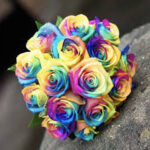
#### Historical Context and Naming
The Pompadour Rose is a flower steeped in history, its name evoking the elegance and sophistication of the French court. To fully appreciate the origins of this rose, we must delve into the historical and cultural backdrop that gave rise to its naming.
#### Madame de Pompadour: The Namesake
The Pompadour Rose is named after Jeanne-Antoinette Poisson, more famously known as Madame de Pompadour. She was a prominent figure in 18th-century France, serving as the official chief mistress of King Louis XV. Her influence extended far beyond her intimate relationship with the king, as she became a key player in the French court, known for her patronage of the arts and her role in shaping French culture and politics.
– **Early Life:** Born in 1721, Jeanne-Antoinette was well-educated and groomed for a life at court. Her rise to prominence was swift, and she caught the eye of King Louis XV, becoming his mistress in 1745. She was later ennobled as the Marquise de Pompadour.
– **Cultural Patronage:** Madame de Pompadour was a major patron of the arts, supporting painters, sculptors, and architects. She played a crucial role in the development of the Rococo style, characterized by ornate decorations and light, pastel colors, which mirrored her own sophisticated and elegant persona.
– **Political Influence:** Beyond her cultural contributions, Madame de Pompadour was deeply involved in political affairs. She advised the king on numerous matters and helped shape the policies of the French state, demonstrating a keen intellect and strategic acumen.
#### The Association with Roses
Madame de Pompadour’s association with roses is both symbolic and literal. Roses have long been a symbol of beauty, love, and nobility, traits that Madame de Pompadour embodied and promoted during her time at court.
– **Symbolism of Roses:** In the 18th century, roses were highly valued for their beauty and fragrance. They were often used in gardens, floral arrangements, and as motifs in art and decor. The rose, with its delicate petals and intoxicating scent, became a metaphor for the refined and cultured life that Madame de Pompadour epitomized.
– **Gardens and Landscaping:** Madame de Pompadour was known for her exquisite taste in garden design. She oversaw the creation of several elaborate gardens, including those at the Château de Bellevue, where roses featured prominently. Her gardens were a testament to her love for horticulture and her desire to create spaces of beauty and tranquility.
#### The Birth of the Pompadour Rose
The Pompadour Rose, named in her honor, captures the essence of Madame de Pompadour’s legacy. This rose variety is celebrated for its lush, multi-petaled blooms and captivating fragrance, reflecting the opulence and elegance associated with its namesake.
– **Cultivar Development:** The development of the Pompadour Rose likely involved the careful selection and hybridization of existing rose varieties. Breeders aimed to create a rose that embodied the qualities admired in Madame de Pompadour—beauty, refinement, and enduring charm.
– **Introduction to Horticulture:** The introduction of the Pompadour Rose to gardens and landscapes would have been met with enthusiasm by those who admired Madame de Pompadour and the cultural renaissance she inspired. This rose quickly became a favorite among gardeners and rose enthusiasts, cherished for its aesthetic appeal and historical significance.
#### Characteristics of the Pompadour Rose
The Pompadour Rose is distinguished by several key characteristics that make it a standout in the world of roses. These attributes not only reflect the rose’s noble heritage but also its suitability for a variety of horticultural applications.
– **Appearance:** The Pompadour Rose typically features large, double blooms with a rich, velvety texture. The petals are often a deep pink or mauve color, evoking the luxurious and refined taste of its namesake. The blooms are known for their intricate layers and captivating beauty.
– **Fragrance:** One of the most notable features of the Pompadour Rose is its strong, pleasant fragrance. The scent is often described as sweet and slightly fruity, adding an olfactory dimension to its visual appeal. This fragrance makes the rose a favorite in perfumery and floral arrangements.
– **Growth Habit:** The Pompadour Rose generally exhibits a robust growth habit, with strong stems and healthy foliage. It can be grown as a shrub or trained as a climber, making it versatile for different garden settings. Its ability to thrive in various conditions reflects the adaptability and resilience of the rose.
– **Cultural Requirements:** Like many roses, the Pompadour Rose requires well-drained soil, ample sunlight, and regular watering. Proper care and maintenance, including pruning and fertilization, help ensure that this rose variety reaches its full potential, displaying abundant blooms and vigorous growth.
#### The Legacy of Madame de Pompadour in Horticulture
Madame de Pompadour’s influence on horticulture extends beyond the rose that bears her name. Her passion for gardening and her support for the arts left an indelible mark on the cultural and botanical landscape of France.
– **Garden Design:** Madame de Pompadour’s gardens were characterized by their elegance and attention to detail. She employed some of the finest landscape architects of her time, creating gardens that were both beautiful and functional. These gardens served as inspirations for future generations of gardeners and designers.
– **Botanical Collections:** Her interest in plants and flowers led to the cultivation of diverse botanical collections. These collections included not only roses but also a wide range of ornamental plants, reflecting the biodiversity and horticultural richness of the era.
– **Cultural Renaissance:** Madame de Pompadour’s patronage of the arts extended to the botanical world. She supported botanical illustrators and gardeners, contributing to the advancement of botanical knowledge and the dissemination of horticultural practices.
#### Pompadour Rose in Modern Horticulture
Today, the Pompadour Rose continues to be a popular choice among gardeners and rose enthusiasts. Its historical significance, combined with its striking beauty, makes it a cherished addition to gardens and floral displays.
– **Heritage and Preservation:** Efforts to preserve heritage rose varieties have ensured that the Pompadour Rose remains accessible to contemporary gardeners. Organizations dedicated to the conservation of historical roses play a crucial role in maintaining the genetic diversity and cultural heritage of these plants.
– **Contemporary Breeding:** Modern breeding programs continue to refine and enhance the characteristics of the Pompadour Rose. Through selective breeding, horticulturists aim to improve disease resistance, bloom longevity, and other desirable traits, ensuring that this rose variety remains relevant and robust in modern gardens.
– **Cultural Significance:** The Pompadour Rose remains a symbol of elegance and refinement, embodying the spirit of Madame de Pompadour. Its presence in gardens and floral arrangements serves as a reminder of the rich cultural and botanical heritage associated with this iconic figure.
#### Conclusion
The story of the Pompadour Rose is intertwined with the life and legacy of Madame de Pompadour, a woman whose influence on French culture and horticulture remains profound. Named in her honor, the Pompadour Rose symbolizes beauty, sophistication, and a passion for the arts. Its historical and cultural significance, combined with its horticultural appeal, ensures that the Pompadour Rose will continue to be celebrated and cherished for generations to come.
As we admire the Pompadour Rose, we are reminded of the enduring legacy of Madame de Pompadour and her contributions to the world of art, culture, and horticulture. This exquisite flower stands as a testament to the power of beauty and elegance, inspiring gardeners and flower lovers around the world to appreciate and preserve the rich heritage of roses.
### The Story and Origin of the Name “Pompadour” Rose (Part 2)
#### Historical Significance of Madame de Pompadour
Madame de Pompadour, beyond her association with the rose that bears her name, left a lasting legacy in various aspects of French society and culture. Her influence extended beyond the confines of the court, shaping the arts, politics, and even fashion of her time.
– **Artistic Patronage:** Madame de Pompadour was a notable patron of the arts, supporting renowned artists such as François Boucher and Jean-Marc Nattier. She commissioned numerous paintings, sculptures, and decorative arts, fostering the development of the Rococo style that characterized the aesthetic of the era.
– **Cultural Influence:** As a tastemaker and trendsetter, Madame de Pompadour played a pivotal role in defining the cultural landscape of 18th-century France. Her refined taste and appreciation for luxury set the standard for elegance and sophistication in French society.
– **Political Acumen:** Despite her position as the king’s mistress, Madame de Pompadour wielded considerable political influence. She participated in diplomatic affairs, mediated disputes, and exerted her influence on matters of state, earning her the admiration and respect of many at court.
#### The Pompadour Rose: A Symbol of Elegance and Romance
The naming of the Pompadour Rose in honor of Madame de Pompadour is a fitting tribute to her enduring legacy. Like the Marquise herself, the rose exudes grace, refinement, and timeless beauty, captivating all who encounter its blooms.
– **Cultural Icon:** The Pompadour Rose has become synonymous with the elegance and romance of the French court. Its association with Madame de Pompadour evokes images of grandeur, opulence, and the pursuit of beauty, reflecting the cultural milieu of the Rococo period.
– **Aesthetic Appeal:** Beyond its historical significance, the Pompadour Rose continues to captivate with its exquisite blooms and intoxicating fragrance. Its lush petals and delicate hues evoke the splendor of a bygone era, inviting admiration and enchantment.
– **Romantic Symbolism:** In the language of flowers, the rose has long been associated with love, passion, and romance. The Pompadour Rose, with its evocative name and sumptuous beauty, embodies these sentiments, making it a favored choice for weddings, anniversaries, and other romantic occasions.
#### Horticultural Legacy of Madame de Pompadour
Madame de Pompadour’s passion for horticulture and garden design left an indelible mark on the botanical landscape of France. Her love for flowers and plants is reflected in the gardens she created and the botanical collections she cultivated.
– **Garden Design:** Madame de Pompadour was renowned for her skill in garden design, creating landscapes that were both aesthetically pleasing and harmonious with nature. Her gardens featured a diverse array of plants, including roses, which were carefully selected and arranged to create captivating vistas.
– **Botanical Collections:** In addition to her gardens, Madame de Pompadour maintained extensive botanical collections, collecting rare and exotic plants from around the world. These collections served as a testament to her curiosity and appreciation for the natural world, inspiring generations of botanists and gardeners.
– **Legacy of Beauty:** Madame de Pompadour’s gardens and botanical collections were not only expressions of her personal taste but also reflections of her desire to cultivate beauty and harmony in the world around her. Her legacy lives on in the enduring beauty of the Pompadour Rose and other plants that bear her name.
#### Modern Cultivation and Appreciation
In contemporary horticulture, the Pompadour Rose continues to be celebrated for its historical significance, as well as its horticultural merits. Gardeners and rose enthusiasts alike cherish this iconic variety for its beauty, fragrance, and connection to the past.
– **Historical Preservation:** Efforts to preserve heritage rose varieties, including the Pompadour Rose, ensure that these historic cultivars remain accessible to future generations. Botanical gardens, arboretums, and private collectors play a vital role in safeguarding the genetic diversity and cultural heritage of these roses.
– **Cultivation and Propagation:** Gardeners continue to cultivate and propagate the Pompadour Rose, both for its ornamental value and its historical significance. Through careful cultivation and propagation, the legacy of Madame de Pompadour and her beloved rose variety is perpetuated and celebrated.
– **Cultural Appreciation:** The Pompadour Rose serves as a symbol of cultural heritage and artistic expression, embodying the elegance and romance of a bygone era. Its association with Madame de Pompadour adds depth and meaning to its allure, inviting contemplation and appreciation of history and beauty.
#### Conclusion: A Timeless Tribute
In conclusion, the Pompadour Rose stands as a timeless tribute to the enduring legacy of Madame de Pompadour—a woman of intellect, influence, and indomitable spirit. Through her patronage of the arts, her passion for horticulture, and her role as a cultural icon, Madame de Pompadour left an indelible mark on history, shaping the aesthetics and sensibilities of her










